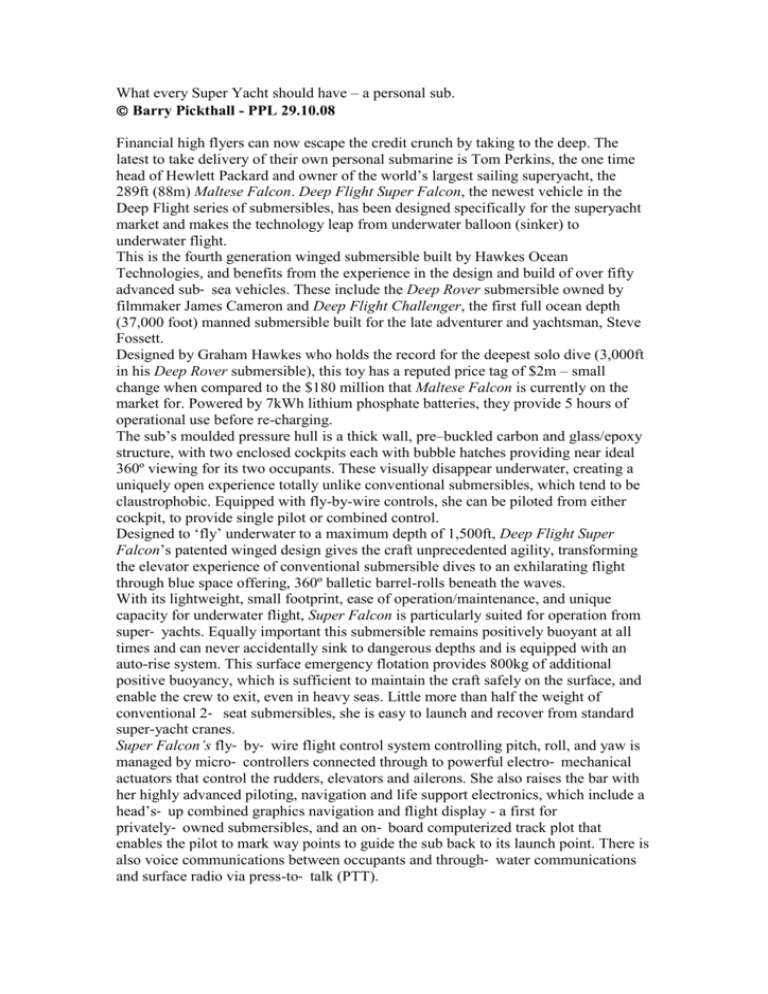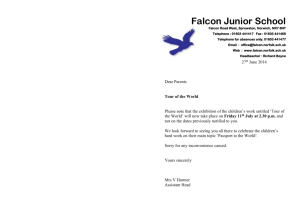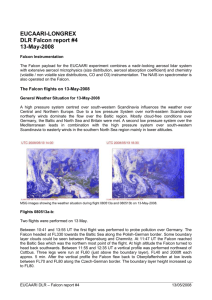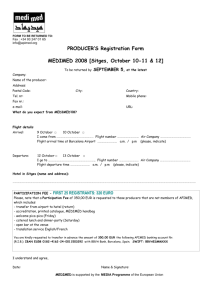What every super yacht should have – a personal sub
advertisement

What every Super Yacht should have – a personal sub. Barry Pickthall - PPL 29.10.08 Financial high flyers can now escape the credit crunch by taking to the deep. The latest to take delivery of their own personal submarine is Tom Perkins, the one time head of Hewlett Packard and owner of the world’s largest sailing superyacht, the 289ft (88m) Maltese Falcon. Deep Flight Super Falcon, the newest vehicle in the Deep Flight series of submersibles, has been designed specifically for the superyacht market and makes the technology leap from underwater balloon (sinker) to underwater flight. This is the fourth generation winged submersible built by Hawkes Ocean Technologies, and benefits from the experience in the design and build of over fifty advanced sub‐ sea vehicles. These include the Deep Rover submersible owned by filmmaker James Cameron and Deep Flight Challenger, the first full ocean depth (37,000 foot) manned submersible built for the late adventurer and yachtsman, Steve Fossett. Designed by Graham Hawkes who holds the record for the deepest solo dive (3,000ft in his Deep Rover submersible), this toy has a reputed price tag of $2m – small change when compared to the $180 million that Maltese Falcon is currently on the market for. Powered by 7kWh lithium phosphate batteries, they provide 5 hours of operational use before re-charging. The sub’s moulded pressure hull is a thick wall, pre–buckled carbon and glass/epoxy structure, with two enclosed cockpits each with bubble hatches providing near ideal 360º viewing for its two occupants. These visually disappear underwater, creating a uniquely open experience totally unlike conventional submersibles, which tend to be claustrophobic. Equipped with fly-by-wire controls, she can be piloted from either cockpit, to provide single pilot or combined control. Designed to ‘fly’ underwater to a maximum depth of 1,500ft, Deep Flight Super Falcon’s patented winged design gives the craft unprecedented agility, transforming the elevator experience of conventional submersible dives to an exhilarating flight through blue space offering, 360º balletic barrel-rolls beneath the waves. With its lightweight, small footprint, ease of operation/maintenance, and unique capacity for underwater flight, Super Falcon is particularly suited for operation from super‐ yachts. Equally important this submersible remains positively buoyant at all times and can never accidentally sink to dangerous depths and is equipped with an auto-rise system. This surface emergency flotation provides 800kg of additional positive buoyancy, which is sufficient to maintain the craft safely on the surface, and enable the crew to exit, even in heavy seas. Little more than half the weight of conventional 2‐ seat submersibles, she is easy to launch and recover from standard super-yacht cranes. Super Falcon’s fly‐ by‐ wire flight control system controlling pitch, roll, and yaw is managed by micro‐ controllers connected through to powerful electro‐ mechanical actuators that control the rudders, elevators and ailerons. She also raises the bar with her highly advanced piloting, navigation and life support electronics, which include a head’s‐ up combined graphics navigation and flight display - a first for privately‐ owned submersibles, and an on‐ board computerized track plot that enables the pilot to mark way points to guide the sub back to its launch point. There is also voice communications between occupants and through‐ water communications and surface radio via press-to‐ talk (PTT). Displacing 1,818kg, Deep Flight Super Falcon has a range of 25 miles, a descent rate of 200ft per minute, and an operational depth of 1,500ft. Further versions are now planned with a larger 3-seater sub on the drawing board and a 4-6 seat version in a larger craft with twin fuselage. Deep Fight Super Falcon – Specifications Manufacturer: Hawkes Ocean Technologies Length: 6m (19ft 8in) Height: 1.6m (5ft 3in) Beam, wings deployed: 3m (9ft 10in) Wings folded for storage: 1.4m (4ft 7in) Displacement: 1,818kg (4000lbs) Payload: 230kg (506lbs) (2 persons) Power: 7kWh lithium phosphate batteries 48V Main Battery System Max descent rate: 200ft/min (61 m/min) Max ascent rate: 400ft/min (122 m/min) Cruise speed: 2-6 knots Cruise range: 25n. miles Cruise depth: 400 – 1,500ft Max thrust: 508lbs (231kg) Pitch/role: +/- 30 Life support duration: 24-72 hours 647 Words








